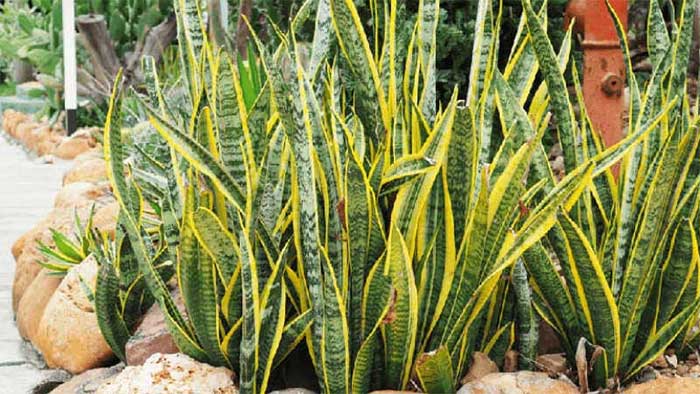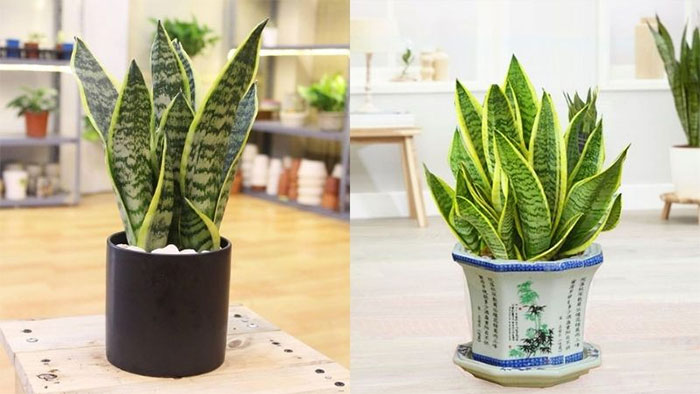The Snake Plant: A Popular Indoor Decoration Many people may not fully understand the significance, benefits, and care tips for the Snake Plant. So, what are the meanings, benefits, and important notes when growing this plant? Let’s explore the interesting information below!
Essential Information About the Snake Plant
To add greenery and vibrant colors to our lives, plants are essential companions. Not only do they enhance beauty, but they also provide fresh air. The Snake Plant is one of these, contributing to a beautiful green environment that adds color to life.
1. What is the Snake Plant?

The Snake Plant belongs to the Asparagaceae family, growing from 50 to 60 cm tall.
Also known as the Tiger Plant or Mother-in-Law’s Tongue, its scientific name is Sansevieria trifasciata. This plant typically grows to a height of 50 to 60 cm. Its flat, succulent leaves appear sharp but are soft to the touch, posing no risk of injury.
Its leaves are characterized by green and yellow stripes running from the base to the tip. When flowering, the Snake Plant produces clusters of blooms that grow from the base and bear round fruits. Many may not know that the Snake Plant originates from tropical regions, with around 70 different species, including the Tiger Snake Plant and the Thai Snake Plant. Currently, the most popular varieties are the Thai Snake Plant and the Tiger Snake Plant.

The Snake Plant is often grown and placed in living rooms.
The Snake Plant is commonly placed in the living room – a space that reflects the owner’s personal style. It is suitable to place next to a TV stand, sofa, or on either side of the entrance, serving as a way to ward off negativity and bring good fortune to the family.
Adding a Snake Plant to the bedroom can enhance the space’s vibrancy, as it can absorb harmful gases like cigarette smoke and nitrogen oxides. This is beneficial for providing additional oxygen for human respiration.
Planting Snake Plants in the bathroom is also ideal since they thrive in low-light conditions. Although bathrooms are often humid, this does not hinder the plant’s growth. Not only are they easy to care for, but their leaves can also absorb moisture and eliminate harmful toxins from the air. Thus, they are an excellent choice for indoor planting.
2. Feng Shui Significance of the Snake Plant
In Feng Shui, the Snake Plant is believed to ward off evil spirits, repel negative energy, and counteract misfortune in life. Its upright leaves symbolize decisiveness and human willpower. The majestic appearance of the plant from its trunk to the tip represents authority and noble lineage.

Upright leaves symbolize decisiveness and human willpower.
The flowers of the Snake Plant add a touch of elegance and carry significant Feng Shui meaning. According to ancient beliefs, those who successfully grow Snake Plant flowers will experience good fortune throughout the year, not only in life but also in their careers and finances.
To maximize its Feng Shui benefits, it is essential to find an appropriate position for the plant. A good placement will help bring luck and facilitate success in both work and life.
3. Health Benefits of the Snake Plant
Asthma Relief
For individuals suffering from asthma, using gel from the Snake Plant mixed with hot water can help. Inhaling the steam allows anti-inflammatory properties to adhere to the nasal and throat mucosa, helping to prevent prolonged asthma attacks and facilitate easier breathing.
Digestive Health Improvement
The components aloin, aloe-emodin, and barbaloin found in Snake Plant leaves can effectively improve stomach function and stimulate digestion. Juice made from Snake Plant leaves can help treat acid reflux, bloating, indigestion, and reduce internal heat.
Stress and Fatigue Reduction
Many people who work all day in an office often experience fatigue and stress. The Snake Plant can help alleviate work pressure while adding a refreshing touch to the environment and providing a sense of relaxation.
Promotes Better Sleep
Unlike many other plants that release CO2 at night, the Snake Plant absorbs toxins through its leaves and releases pure oxygen, creating a clean environment that promotes deeper, more restful sleep.

The Snake Plant has antibacterial and anti-inflammatory properties.
Reduces Skin Allergies
The Snake Plant has similar properties to aloe vera, possessing antibacterial and anti-inflammatory qualities that can be used to treat various skin allergies. When skin is burned, blistered, sunburned, or scratched, it serves as a natural method for effective disinfection.
Air Purification and Toxin Removal
NASA has reported that the Snake Plant effectively purifies the air, as it can absorb environmental pollutants and 107 toxins, including carcinogenic substances like nitrogen oxide and formaldehyde.
Public spaces such as office buildings, hospitals, or homes can benefit from planting Snake Plants to enhance air quality. Growing this plant will help purify the air, eliminate bacteria, and gradually reduce symptoms like coughing, runny nose, and sneezing caused by airborne pathogens.
4. Care Tips for Growing Snake Plants Indoors

The Snake Plant does not require excessive watering as it is prone to root rot.
Light conditions are crucial for this plant, as it prefers warm environments and is sensitive to cold. It thrives well indoors or in shaded areas.
The Snake Plant is not picky about soil and can grow in various types, from dry soil to sandy or gravelly mixes. To enhance its growth, it is best to plant it in alkaline soil.
Snake Plants do not require excessive watering as they are susceptible to root rot; watering should be limited, and attention should be paid to soil drainage.


















































